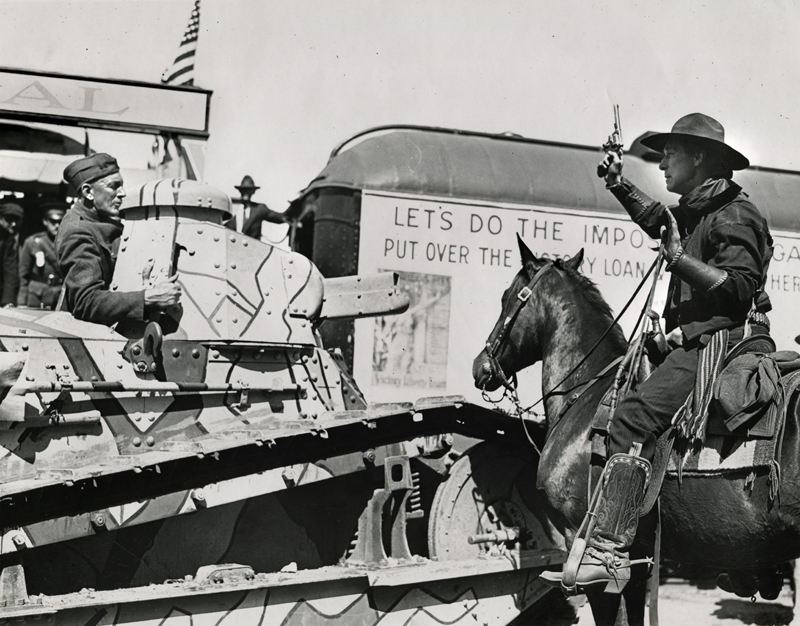|
|
William S. Hart

Click image to enlarge April 16, 1919 — Actor William S. Hart stages a mock holdup of the Liberty Loan train in San Fernando, Calif., as a publicity stunt to promote the 5th Liberty Loan bond series. Apparently a tank drives up to save the day — and sell Bill a bond. An unknown person's handwriting on the back of this 8x10 glossy publicity photograph reads: "San Fernando, Cal., April 16, 1919 / Taken during the holding up of the 5th Liberty Loan train by Wm. S. Hart and Co. / The Whippet tank selling Bill a liberty bond." The fifth and final bond series of World War 1 was issued April 21, 1919, five days after this photo was shot — and five months after the war ended. Thus the 5th series was known as the Victory Liberty Loan. The issue consisted of $4.5 billion in tax-exempt bonds earning 4.75 percent interest, with principal and interest payable in gold. Unlike the earlier 4th series, which would eventually go into technical default because the government didn't call the bonds until 1934 — after Congress had devalued the dollar and outlawed the private ownership of gold — the 5th series matured after just 4 years and could be redeemed by the government after three years. (Series 1-3 also matured in the 1920s and averted the problem.)
BILL HART AND THE WARS By Bill Crowl, President, Friends of William S. Hart Park & Museum (1999)
William S. Hart was born at the end of the American Civil War. His childhood mentors were still afire with patriotism and the need to rebuild a nation once divided. Bill's early teens were lived on the American frontier where western freedom abounded. Throughout his life, he was visibly proud to be an American. Bill was in his early 50s when the United States entered the (First) World War. Though physically fit, he was too old to be accepted into the military. But, as the leading Western movie star of the period, Bill found other ways to support his nation. He raised money for the Liberty Loan drives and for the Red Cross records show that Hart's tours for the third Liberty Loan drive were responsible for over $2 million in contributions. A little earlier, in 1917, Bill co-starred with Douglas Fairbanks and Mary Pickford in a one-half reel Liberty bond sales promotional film. Hart fired the first gun in the Second Liberty Loan. For the fourth Liberty Loan drive, Bill wrote, directed and starred in a another sales promotion film. While asleep, by his pinto pony, Bill dreamed of a visit to Berlin, where he busted through a window into the Royal Palace. There, he shot it out with the Kaiser and his Huns, in Western saloon-hall fashion. After comparing the German leader to a rattlesnake, but letting him live, Bill rode off, hell-bent for leather, to buy Liberty bonds. Hart really did purchase a substantial amount of bonds. Bill also enlisted his pinto pony "Fritz" in the post-war effort. They paraded the streets of Los Angeles to secure funds for the American Red Star Animal Relief which provided hospitals and veterinaries for the thousands of horses, mules and dogs that were wounded while fighting with the American troops on the western battlefront. The 159th California Infantry showed their appreciation of Bill Hart by choosing the western film star as their godfather. They took on the name of "Bill Hart Two-gun Men." Practically every other unit, among the 30,000 troops at Camp Kearny (near San Diego), vied for this sobriquet, but the 159th landed Bill. Within seven months of Hart's donation of the American Theater to American Legion Post 507, our nation entered the Second World War. Bill was much older now, retired and living in Newhall. However his patriotism still burned brightly, and he was still respected as an early Western movie star. To this end, Bill donated many of his personal artifacts, including boots and Stetsons, to be auctioned at war bond sales rallies.
LW2414: 9600 dpi jpeg from original print purchased by Leon Worden. |
1917
Military Ball 5/11/1918
"A Bullet for Berlin" 1918 (4th Series)
4th Series 10/3/1918
4th Series 1918/19
5th Series 1919
|
The site owner makes no assertions as to ownership of any original copyrights to digitized images. However, these images are intended for Personal or Research use only. Any other kind of use, including but not limited to commercial or scholarly publication in any medium or format, public exhibition, or use online or in a web site, may be subject to additional restrictions including but not limited to the copyrights held by parties other than the site owner. USERS ARE SOLELY RESPONSIBLE for determining the existence of such rights and for obtaining any permissions and/or paying associated fees necessary for the proposed use.





